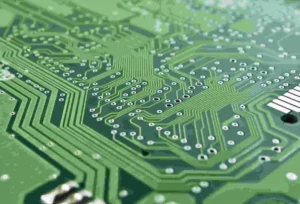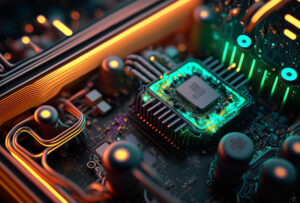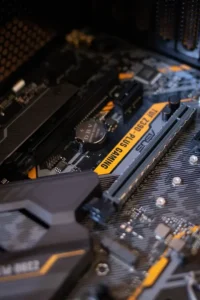According to an article Published in the Times of India, Institutes in Gujarat got a grant of 3.8 crores for VLSI design. This plays a pivotal role within the contemporary technological landscape. This specialized field governs the meticulous creation of integrated circuits (ICs) harboring millions, or even billions, of microscopic transistors, meticulously arranged upon a singular chip. VLSI basics are the foundation required to create these marvels of miniaturization empowering a vast array of electronic devices, ranging from ubiquitous smartphones and omnipresent laptops to sophisticated medical equipment and spacecraft traversing the cosmos. A foundational understanding of its core principles is paramount to fully appreciate the profound impact of VLSI design on the modern world.
The Evolutionary Path Towards Miniaturization
- The Miniaturization Revolution: The story of VLSI design starts with the invention of the transistor in 1947. This tiny device replaced bulky vacuum tubes, allowing electronics to shrink and become more powerful.
- Early Steps: Small-Scale Integration (SSI) and Medium-Scale Integration (MSI) only had a few transistors (tens or hundreds) on a chip.
- The Need for Speed: Large-scale integration (LSI) arrived in the 1970s, squeezing thousands of transistors onto a single chip, fulfilling the growing demand for processing power.
- Moore’s Law in Action: This period coincided with the rise of Moore’s Law, which predicted the doubling of transistors on a chip roughly every two years.
- The VLSI Leap: By the 1980s, VLSI design took centre stage, marking a giant leap in miniaturization, allowing billions of transistors to be integrated into a single chip.
An Exploration VLSI basics in CMOS Technology
Complementary Metal-Oxide-Semiconductor (CMOS) technology serves as the cornerstone of VLSI design as CMOS is less power-consuming than the TTL and BJT technology. This established technology leverages two distinct types of transistors: the N-channel MOSFET (NMOS) and the P-channel MOSFET (PMOS). These transistors function as microscopic switches, selectively permitting or hindering the flow of current based on the applied voltage. By meticulously combining these transistors to form intricate logic circuits, complex computations can be executed.
From Conceptualization to Chip Fabrication
The meticulous process of creating a VLSI chip entails a rigorously defined sequence of steps:
- Functional Specification: The initial stage lays the groundwork by clearly delineating the desired functionality of the chip. This critical phase meticulously defines the problem the chip aims to address and the specific tasks it will execute.
- Architectural Design: The overall architectural blueprint of the chip is meticulously crafted. This blueprint encompasses the type of processing units, memory elements, and communication channels necessary for optimal performance.
- Logic Design: Hardware description languages (HDLs) such as Verilog or VHDL are employed to design the logic circuits. These specialized languages offer a human-readable format for describing the behavior of the circuit.
- Simulation and Verification: Rigorous simulations are conducted to meticulously evaluate the functionality and performance of the circuit design. This phase is vital for identifying and rectifying any errors that impede functionality.
- Fabrication: A process known as photolithography meticulously transfers the chip layout onto a silicon wafer. Subsequent layers of metal are deposited to establish the necessary electrical connections.
- Circuit Design: Computer-aided design (CAD) tools are utilized to translate the logic circuits into intricate layouts comprised of transistors, wires, and crucial interconnections.
- Packaging and Testing: The fabricated chips undergo rigorous testing procedures to ensure they adhere to the predetermined specifications. Only chips that meet these stringent criteria are deemed operational.
Key Challenges in the Realm of VLSI Design
Despite the remarkable advancements achieved in VLSI design, several significant challenges persist
- Power Consumption: As the density of transistors continues to escalate, so too does power consumption. Managing heat dissipation effectively remains a critical concern within VLSI design.
- Manufacturing Intricacies: The fabrication of chips harbouring billions of transistors necessitates exceptionally precise and immaculate manufacturing processes. Even a minute imperfection can render the entire chip inoperable.
- Design Complexity: Designing and subsequently verifying intricate VLSI circuits demands the utilization of advanced tools and the expertise of highly skilled engineers.
- The Future Beckons: Pushing the Boundaries of VLSI Design
The relentless pursuit of miniaturization continues unabated, with researchers actively exploring novel technologies such as 3D stacking of transistors to achieve even greater transistor density on a single chip. Furthermore, investigations are underway to explore the potential benefits of new materials like Gallium Nitride (GaN), particularly for applications requiring high-frequency operation.
The Enduring Impact of VLSI
VLSI design stands as a testament to human ingenuity. By miniaturizing billions of transistors onto a single chip, we have effectively created powerful tools that continue to revolutionize our world. This remarkable field has demonstrably led to:
- The proliferation of smaller and more potent electronic devices.
- A substantial increase in processing speed and overall efficiency.
- The development of complex functionalities such as artificial intelligence and machine learning, are transforming numerous industries.
- A significant reduction in the cost of electronics, making them more accessible to a wider global audience.
Conclusion
VLSI design stands as a crowning achievement of human ingenuity. It represents the culmination of meticulous research, groundbreaking discoveries, and relentless innovation. By meticulously crafting microscopic marvels containing billions of transistors, we have effectively empowered a technological revolution that continues to reshape the world around us. As technology continues its relentless march forward, VLSI basics undoubtedly occupies a pivotal position, paving the way for even more incredible breakthroughs that will shape the future. If you are interested to know more about VLSI then come join ChipEdge, It is among the best VLSI institutes in Bangalore.
Our VLSI physical design course is curated and delivered by industry experts, catering to the professional development of working individuals and postgraduates alike. With provisions for placement assistance and certification, we guarantee a holistic educational journey. We invite you to contact ChipEdge today to enroll in the best VLSI online course.















